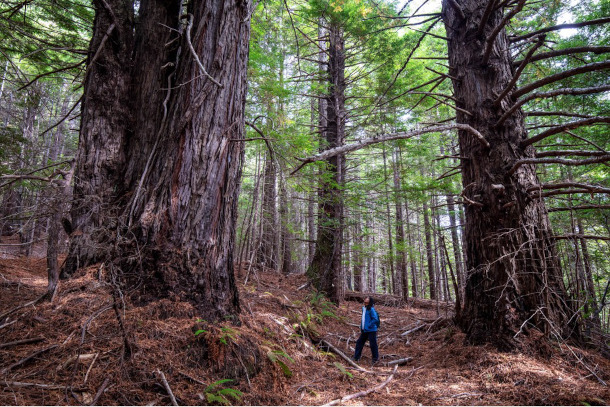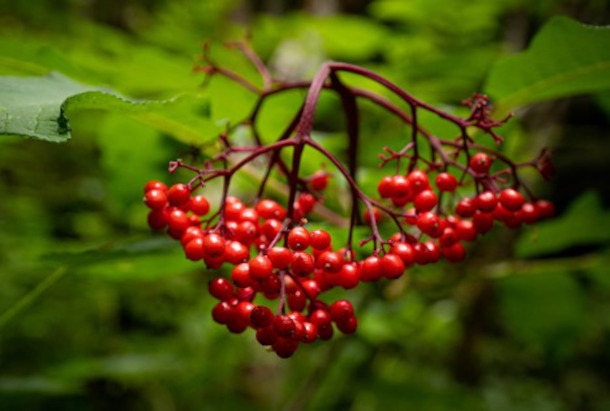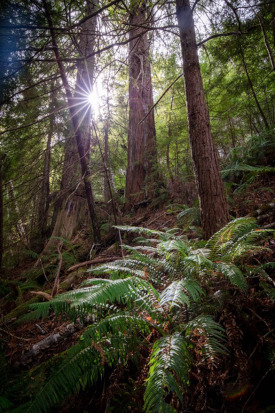Redwoods Returned to Tribes
Air Date: Week of March 11, 2022

Tc’ih-Léh-Dûñ is a 523-acre property, now owned by the InterTribal Sinkyone. (Photo: Max Forster (@maxforsterphotography), courtesy of Save the Redwoods League)
A consortium of ten tribal nations are now the permanent guardians of more than 500 acres of coast redwood forest in northern California. Buffie Schmidt with the Intertribal Sinkyone Wilderness Council joins Host Jenni Doering to talk about the relationship between this rugged stretch of California coast and the local Native cultures.
Transcript
DOERING: For thousands of years the Sinkyone people of northern California thrived among ancient coast redwoods, the tallest trees in the world. But the arrival of European settlers and logging brought genocide to the people and the trees they considered family, severing them from their sacred lands. Now, as part of a landback movement across North America, the Indigenous people of coastal northern California are restoring that relationship. A consortium of ten tribal nations called the Intertribal Sinkyone Wilderness Council are now the guardians of a 523-acre property called Tc’ih-Léh-Dûñ that contains 200 acres of old-growth coast redwoods. The nonprofit Save the Redwoods League was able to purchase the property with $3.5 million in conservation funding from Pacific Gas and Electric and has transferred ownership of the forest to the Sinkyone Council for permanent protection. Buffie Schmidt is a Northern Pomo Language Teacher and Treasurer of the Intertribal Sinkyone Wilderness Council and joins me now to discuss. Welcome to Living on Earth!
SCHMIDT: Thank you, Jenni.
DOERING: So first Could you tell us who you are? And do you have a Pomo name in addition to Buffie Schmidt that you would like to share?

Fungus growing on a log in Tc’ih-Léh-Dûñ. (Photo: Max Forster (@maxforsterphotography), courtesy of Save the Redwoods League)
SCHMIDT: It would be my honor to introduce myself and my northern Pomo language. [Tsin t̪a ma naʔ Maːt̪a Mit̪a' ʔa: na. Shibal dano pʰoʔo maʔ, Noyo naː Ukia kʰe ʔa: na. Amiˈe Thomas Campell Sr. Shibal dano pʰoʔo maʔ naː Noyo kʰe moːw na. Amiˈtʰe Christine Hamilton. Ukia kʰe maːn na.]. My name is Buffie Schmidt. I come from Sherwood Valley Noyo and Rancheria. My father Thomas Campbell comes from Sherwood Valley and Noyo reservation. And my mother Christine Hamilton comes from Rancheria. I'm proud to say that I am a traditional Pomo basket weaver I was taught by my mother, Christine Hamilton. And she was taught by Elsie Allen and Elsie Allen and was taught by her mother, and so on and so forth. These teachings shared culture have been passed down from generation to generation, just like our language not learned in schools or textbooks, but by oral physical hands on teachings.
DOERING: So could you tell me about the name of this place? We're talking about today? Tc’ih-Léh-Dûñ. So what is the meaning of that phrase?
SCHMIDT: Tc’ih-Léh-Dûñ means fish run place. And it's Sinkyone. It's a indigenous language of the area. And there are coho salmon that are running in the streams in the wild there.
DOERING: And so where along the California coast, are these 523 acres called Tc’ih-Léh-Dûñ and what is it like to spend time there?

Red elderberry in Tc’ih-Léh-Dûñ. (Photo: Paul Robert Wolf Wilson, courtesy of Save the Redwoods League)
SHMIDT: The property, the 523 acres that was donated back to the Sinkyone member tribes is located in Northern California, specifically in the Mendocino County area. Sometimes people have referred to it as the last coast. It's wild. It's the way the Creator YaKaPede intended it to be: a beautiful, natural place where redwoods can thrive. And because of our land back acquisition, all ecosystems can feel safe that they will prosper and live out their lives without having to worry about overdevelopment, logging.
DOERING: Right, because there was a long history of logging in this area, I understand. And there is still some old growth there of the coast redwoods. Could you tell me a bit about that backstory of what's happened to the land and to the people on the land going back centuries?
SCHMIDT: Surprising to me and the member tribes, some people don't know the history of the area, don't realize that they're standing on indigenous First Nation people grounds. We come from a long time of atrocities bestowed on the native people in this area and our relatives [Katˈil xale], our redwoods have been there for hundreds of years, there are many old growth redwoods in that area. And they're still in danger of being logged by timber companies. And the reservation that I spoke of that I come from Noyo reservation is in the city of Fort Bragg. And my people 100 years ago, lived on the beach there in the Noyo Harbor. And when the milling company came in, they moved our people up to the cliff, because they were going to use that harbor as logging to move ships, boats logging in and out in and out. And so my people were in the way there. So they moved us up above the coasts there. We still have that land.
DOERING: Could you describe looking back to the time of these ancestors? What kind of relationship would they have had with the fish, the coho salmon, you mentioned with other species and with the trees themselves of this region.

Western swordfern at the base of a coast redwood tree in Tc’ih-Léh-Dûñ. (Photo: Max Forster (@maxforsterphotography), courtesy of Save the Redwoods League)
SCHMIDT: My ancestors as well as Sinkyone Board have a reciprocal relationship with the land that the Creator YaKaPede has provided for us. We take what we need and not any more. We try to tend to land so that it'll grow better the next season, and that will always be there. And there's a balance. There's a cycle there. That's how our ancestors lived. And that's what our people today are trying to get back to. There was a disconnect during the Gold Rush movement. When settlers first came in first contact. It was shameful to be an indigenous person to be [hilthin]. So that generation was trying to assimilate to the the new world and lost a lot of their traditions, their gathering spots, their hunting and their fishing grounds and their way of life. And the next generation, again, assimilation and colonization, lost even more. So my generation and the generation next to me are trying to catch up to that. We're trying to remember and to learn our cultural ways to be like our ancestors were, to honor the lands, the sky, the water.
DOERING: How do you think the land back movement can help indigenous people reconnect with their traditional values? And how does it help provide some healing and reconciliation after the cultural genocide that's taking place here in North America?
SCHMIDT: To have land acknowledgement and land physically back means that we are being seen as a native people, not just that we are people that were part of a genocide in discovering these Americas. People can see that we're still here. It brings awareness to our tribes and our cultures and stops the erasure of our cultural traditions and stops genocide.
DOERING: Buffie Schmidt is a northern Pomo language teacher and is treasurer of the intertribal Sinkyone wilderness Council. Thank you so much, Buffie.
SCHMIDT: Thank you, Jenni. I appreciate this opportunity to speak on behalf of the Sinkyone board. Our sacred ceremonies and our prayers were done on these places that we hold so dear. And now we can feel triumphant to receive land back not only in our hearts, but on paper too. [YahWi! K’edi wadim! ] Thank you walk well.
Links
The New York Times | “Redwood Forest in California Is Returned to Native Tribes”
Living on Earth wants to hear from you!
Living on Earth
62 Calef Highway, Suite 212
Lee, NH 03861
Telephone: 617-287-4121
E-mail: comments@loe.org
Newsletter [Click here]
Donate to Living on Earth!
Living on Earth is an independent media program and relies entirely on contributions from listeners and institutions supporting public service. Please donate now to preserve an independent environmental voice.
NewsletterLiving on Earth offers a weekly delivery of the show's rundown to your mailbox. Sign up for our newsletter today!
 Sailors For The Sea: Be the change you want to sea.
Sailors For The Sea: Be the change you want to sea.
 The Grantham Foundation for the Protection of the Environment: Committed to protecting and improving the health of the global environment.
The Grantham Foundation for the Protection of the Environment: Committed to protecting and improving the health of the global environment.
 Contribute to Living on Earth and receive, as our gift to you, an archival print of one of Mark Seth Lender's extraordinary wildlife photographs. Follow the link to see Mark's current collection of photographs.
Contribute to Living on Earth and receive, as our gift to you, an archival print of one of Mark Seth Lender's extraordinary wildlife photographs. Follow the link to see Mark's current collection of photographs.
 Buy a signed copy of Mark Seth Lender's book Smeagull the Seagull & support Living on Earth
Buy a signed copy of Mark Seth Lender's book Smeagull the Seagull & support Living on Earth

